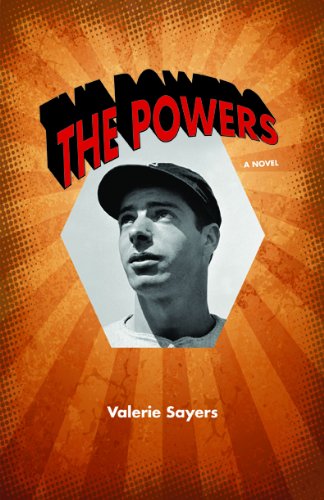
Guest contributor: Valerie Sayers
Baseball, Joe Dimaggio, and Pacifism: Colbert, How Can You Resist?
categories: Cocktail Hour / Reading Under the Influence
Comments Off on Baseball, Joe Dimaggio, and Pacifism: Colbert, How Can You Resist?
Really? Joe DiMaggio? Another WWII novel?
I know. Like everything I write, this new novel, The Powers, just followed me around and insisted on being written till it wore down my resistance. It started during a conversation my then-draft-age sons were having about the Iraq War and whether they could in good conscience claim C.O. status. That topic led us to WWII, the one war we collectively tend to think of as the “good war,” which led me to think about 1941.
So what’s the connection between baseball, photography, and pacifism?
DiMaggio’s 1941 hitting streak remains one of the greatest feats ever, equal parts psychological will and physical bravado. I was interested in the way a whole country trying to decide the right thing could project their ideas of a hero onto a single man’s shoulders (which hurt very badly that summer). Everyone made Joe such a Superman that I gave him the power to foretell the future (there are a lot of quasi-magical powers floating through the book). Walker Evans’s subway photos are another kind of witness to the weariness of ordinary folks during those pre-war years. And finally I was interested in the way pacifists maintained their sanity as they took in the news from Europe, and how they tried to be witnesses, and heroes, and mostly failed.
How are all those photos in the book supposed to work?
The prose is the primary narrative, the photos another, parallel way of seeing. They’re almost all portraits, some of New Yorkers on the subway or on job sites, some of passengers on the SS St. Louis, fleeing Germany (nearly all the passengers on the St. Louis were refused entry in Havana, and Roosevelt refused to intervene to grant them entry to the U.S.). It was important to me that the images of the refugees not portray them as stereotypical victims, so many of the photos are joyful: the final image shows a couple of handsome young guys roller-skating on the deck of the St. Louis.
Did writing the novel help you figure out your own position on pacifism?
No. It remains a moral quandary,but it’s one worth wrestling with. And meanwhile I did revel in some extraordinary photographs, and got to re-live a whole lot of swell baseball games, play by play.
What’s with you and Stephen Colbert?
You might say The Powers is a meditation on Colbert’s favorite subject, America. Plus, we’re both Catholics from South Carolina. In my trailer, I shamelessly beg for the Colbert bump. Are you listening, Stephen?
[Valerie Sayers’s new novel, The Powers, has just been published by Northwestern University Press. It’s about baseball, pacifism, and photography, and it’s set in the year 1941, the year of Joe DiMaggio’s famous hitting streak and Walker Evans’s surreptitious subway photos, the year isolationists and interventionists and pacifists duked it out. She teaches in the MFA writing program at Notre Dame.]



